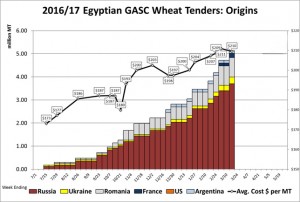- The USDA’s March WASDE, ongoing favourable S American weather and broken down chart patterns all continue to weigh on prices in Chicago. On the week, May corn is down 17 cents, Chicago wheat is down 11 and beans are down 33. May beans’ failure to find support at its 200-day moving average is cited, though we do not advise chasing breaks amid better than expected Chinese soybean imports (from all origins), and as NASS’s planting intentions report is just week away. There is talk that a cargo of Argentine corn has been sold into Vera Cruz, Mexico for July arrival. No price has been offered, nor is there any confirmation but the rumour is pretty widespread in the cash market. Changes in Mexican corn trade will be a hot issue through 2017, particularly as S American cash prices drop during/after harvest. Otherwise, relative to recent days, there’s real dearth of fresh news.
- Russian cash wheat prices this week are down for the only the second time since December. Spot offers rest at $190/mt, down $3/mt on the week. New crop Russian offers are pegged at roughly $177/mt, which is comparable to $4.30, basis July Kansas futures. Recall the seasonal trend in Russia’s cash wheat market tends to be weak in Mar/Apr.
- Fundamental input has turned bearish this week amid confirmation of rising crop sizes in S America, a slight boost in monthly Malaysian palm oil stocks/use, and the lack of any evidence of dryness in Center-West Brazil in the weeks ahead. Our outlook remains neutral until new crop US crop conditions are known, but this year’s S American harvest will weigh heavy on rallies.
Our weekly fund position charts can be downloaded by clicking on the link below:
Fund positions


